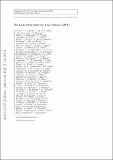The Large Observatory for X-ray Timing (LOFT)
Author(s)
Chakrabarty, Deepto; Remillard, Ronald A
DownloadChakrabarty_The Large.pdf (3.242Mb)
OPEN_ACCESS_POLICY
Open Access Policy
Creative Commons Attribution-Noncommercial-Share Alike
Terms of use
Metadata
Show full item recordAbstract
High-time-resolution X-ray observations of compact objects provide direct access to strong-field gravity, to the equation of state of ultradense matter and to black hole masses and spins. A 10 m[superscript 2]-class instrument in combination with good spectral resolution is required to exploit the relevant diagnostics and answer two of the fundamental questions of the European Space Agency (ESA) Cosmic Vision Theme “Matter under extreme conditions”, namely: does matter orbiting close to the event horizon follow the predictions of general relativity? What is the equation of state of matter in neutron stars? The Large Observatory For X-ray Timing (LOFT), selected by ESA as one of the four Cosmic Vision M3 candidate missions to undergo an assessment phase, will revolutionise the study of collapsed objects in our galaxy and of the brightest supermassive black holes in active galactic nuclei. Thanks to an innovative design and the development of large-area monolithic silicon drift detectors, the Large Area Detector (LAD) on board LOFT will achieve an effective area of ~12 m2 (more than an order of magnitude larger than any spaceborne predecessor) in the 2–30 keV range (up to 50 keV in expanded mode), yet still fits a conventional platform and small/medium-class launcher. With this large area and a spectral resolution of <260 eV, LOFT will yield unprecedented information on strongly curved spacetimes and matter under extreme conditions of pressure and magnetic field strength.
Date issued
2012-10Department
Massachusetts Institute of Technology. Department of Physics; MIT Kavli Institute for Astrophysics and Space ResearchJournal
Experimental Astronomy
Publisher
Springer Science + Business Media B.V.
Citation
Feroci, M., et al. "The Large Observatory for X-ray Timing (LOFT)." Experimental Astronomy, October 2012, Volume 34, Issue 2, pp 415-444.
Version: Author's final manuscript
ISSN
0922-6435
1572-9508